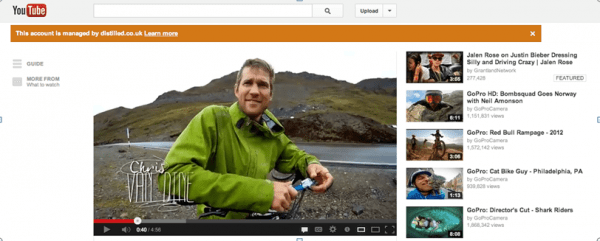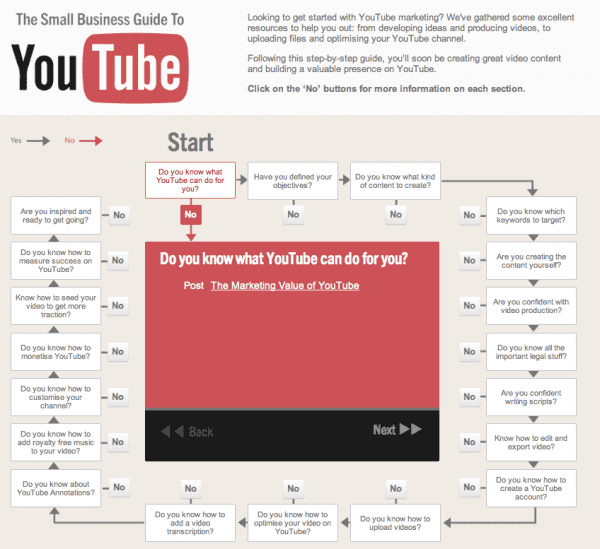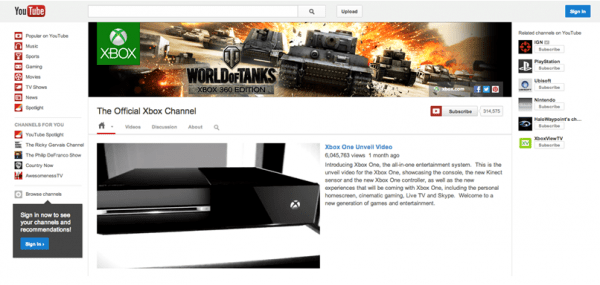Examples and tips showing how to get the best out of YouTube
While YouTube is certainly an ideal place to while away the hours before quitting time at work, many people also view it as the place to head when they want to learn about...pretty much anything. Of course, all of this translates into a lot of people spending a lot of time viewing and posting content on YouTube every hour of every single day of the week. With all of these people looking to YouTube to guide them in everything from their choice of car to the finer points of craft beer making, unless your brand includes YouTube as part of its strategy, you are likely missing out on valuable opportunities to expand awareness of your brand, increase your online visibility, attract new customers, and deepen relationships with current customers. Embarking on a new or amplified content strategy can be daunting, but rest assured that YouTube success is well within reach.

With a little research, some help from this reliable YouTube guide, and some creativity, your brand can maximize its YouTube success within a short period of time.

In order to help you on your way to YouTube glory, we have assembled a list of tried and true approaches, as well as some case studies of businesses that are succeeding in the world of video marketing.
Approach 1: Extend Your Brand's Narrative:
Your video marketing strategy should seek to deepen your brand's unique story, but it should not attempt to create an entirely new narrative. Doing so risks alienating loyal customers and followers and will go a long way to foster mistrust of your brand. This is exactly what you do notwant to happen. Instead of attempting to recast your brand via video, a better strategy is to capitalize on positive aspects of your brand's story that are proven crowd pleasers. If, for example, your organization is known for its aversion to sweatshop labor, then this is an angle to explore in your video strategy. In this way, your brand deepens a reputation that already exists rather than casting about for a new story to capture viewers.
Case Study: Unlike many a fast food chain, Chipotle advertises a commitment to "food with integrity." Accordingly, they are quick to remind customers of their reliance on local farmers and artisans, and to present themselves as healthier and more ethical than competitors. The brand's YouTube channel has little in common with other fast food chains -- no discussion of big deals, or cheap menus, or huge portions. Instead, the company leads with sustainability. Their video selection includes footage of trips to the farms the company uses, compelling How it all Began stories, and clever animated shorts that highlight the company's commitment to ethical food production. The brand demonstrates coherence of message throughout their marketing strategies, and their video content deepens and extends that narrative.
Approach 2: Post Videos that Add Clear Value
Many of the rules that govern content production across other media platforms hold for video marketing as well. As with a blog post, video content should provide something of immediate use value to the viewer. ("But what about all of those videos of cats playing pianos and of double rainbows," you might object -- until you realize that those do provide value. They're funny, and they provide viewers with a chance to share among their communities.) There are all sorts of ways that video content can provide value: it can make someone laugh, introduce them to a new thought leader, teach them how to do something, get them to make a donation they can feel good about, etc. In addition to increasing trust in what you have to offer, an additional bonus of creating highly valuable content is that viewers are more likely to share something that was useful to them with their contacts, thus increasing your reach.

Case Study: Khan Academy is one of the great YouTube success stories. That story goes that Sal Khan began tutoring his cousins remotely in math and was such a good tutor that suddenly he was tutoring more kids than he could handle while still working his hedge fund job. His solution was to post instructional videos on YouTube the kids could watch anytime. He was surprised at how many strangers started to watch his videos and Khan Academy was born. Of course, all of the videos are instructional, but that is not what Khan Academy such a good case study. What makes their approach to video so innovative is that they enhance value in each video by ensuring that each module is more useful than a traditional "How To." This means that there are lots of graphics, lots of opportunities to watch someone doing or thinking about the process, and a real commitment to breaking down complicated concepts into easily digestible bits.
Approach 3: Develop an Organized Brand Channel:
If you only intend to have one or two videos on YouTube, then this tip might not make much sense for you to pursue, but if video is a large component of your content strategy, then consider developing a brand channel that viewers can subscribe to. A brand channel is your brand's home within YouTube, where all your videos are housed together in a neatly organized library. The brand channel interface also allows you to integrate your other social media accounts with your YouTube content. The benefits of this are many, including ease of search for viewers who want to watch your videos and an activity feed that shows viewers what you've been up to.

Case Study: The XBox brand channel organizes materials across a variety of games and platforms in a way that remains user-friendly despite the amount of content that is posted. Through their carefully curated channel, they are able to organize a vast array of material that appeals to wildly different audiences in a non-chaotic and organized fashion. (While all viewers on the site are probably interested in gaming, some might be interested in Forza Motorsport 5, while others want all the latest information on Call of Duty, for example.) One thing to note particularly from this example is the way that the videos titles and descriptions are optimized for search: all the titles include specific key words (XBox One, Splinter Cell Blacklist, etc.), and all the video descriptions do this as well. In this way, a Forza fan, for example, need not waste his time slogging through search results irrelevant to his interests.
The Takeaway:
Video marketing doesn't need to be everything to everybody. In fact, it shouldn't aim to be that at all. Instead, your YouTube efforts should aim to tell your brand's story in a compelling way, offering useful information that viewers will want to share along the way. Remember: your video doesn't need to go viral to be successful. Leave that to the cats and babies of the world. With some strategic planning and the creativity you bring to all of your other marketing efforts, you are bound to meet with success. Good luck!

Thanks to
Luke Clum for sharing their advice and opinions in this post. Luke is a writer and internet marketer for
Distilled. You can follow him/her on
Twitter or connect on
LinkedIn.






 Thanks to
Thanks to 

